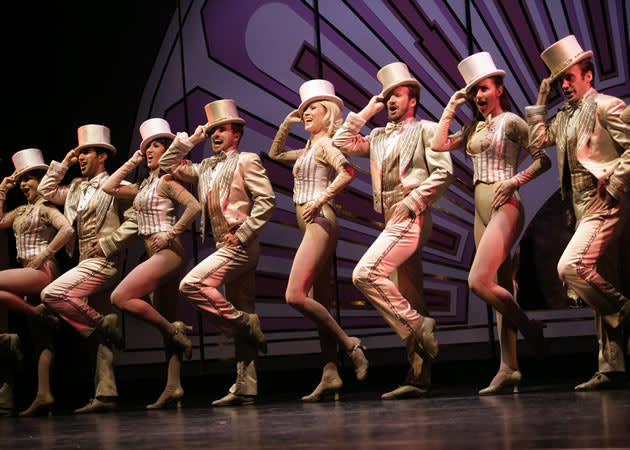‘A Chorus Line’ enchants without the frills

Forget million-dollar sets, elaborate, heavy costumes and star power. A Chorus Line proves itself every bit of a solid musical as the likes of Wicked and The Lion King, without the need for those frills.
The play, now showing in Singapore at the Marina Bay Sands Theatre, enchants even without requiring the audience to follow the story arc of a lead character.
In fact, as the show I watched on Friday came to a glittery, golden end, I realised that the threadbare premise -- the search for four girls and four boys for a line of backup dancers -- really didn't matter as much as I expected it to when the two-hour, no-intermission performance began.
Even though I can't remember the names of all 17 quirky characters, each based on the experiences of an actual group of dancers as recorded on video starting in 1974, what struck me was the genuine, raw stories they told of their lives, which were convincing because they really were real.
As you might imagine, A Chorus Line is different from many other musical or Broadway shows one may watch, not only because there are no obvious stars, fancy costumes or sets (save for a series of revolving mirror panels, a single white line drawn across the bare stage, and one scene where a few angled mirror panels fly in), but also because of the sheer amount of acting and singing involving every person in the Australian ensemble cast.
I found some splendid voices in Karlee Misipeka, who plays Diana, the feisty girl from the "Bronx"; and the character Cassie, the veteran dancer played by Anita Louise Combe, although her solo dance sequence somehow fell short in terms of her lines, particularly compared with the strong technique and solid form of Leah Lim as Connie. Acting as the sole Chinese-American character, Lim also carries a strong singing voice.
(And here's a piece of trivia: Connie is also the character whose story belongs to Baayork Lee, one of the original 17 dancers who led the restaging direction for the show.)
Several other actors appealed to me through their vivid portrayal of their characters, like Debora Krizak's unforgettable performance of Sheila, a self-important, attractive but ageing dancer. From the way she coiffed her curls, removed her hair tie with a flourish and tucked it seductively into her bra, to her constantly poised posture, placing one toe gracefully in front of her back foot whenever she was standing in the line, she held the focus of the audience whenever she spoke or sang.
Others who really brought their personae through were Scott Morris, who played the youngest character, Mark, who feared he had gonorrhoea after his first wet dream, and certainly the stand-out "plastic" girl Val, played to a T by Hayley Winch.
The show struck me in moments of poignancy like the scene where Sheila, Bebe and Maggie come together to sing "At the Ballet", simultaneously sharing pieces of their life stories both beautiful and sad, and certainly Paul's monologue, where he tells his story of how his parents discovered he was gay, but yet extended their love to him.
It was also here, embarrassingly, that I discovered the song "Sing!", covered by Harry Shum and Jenna Ushkowitz (better known as Mike and Tina) on Glee, was originally performed here.
Lighting also plays a strong role in setting the tone and mood of each dancer as he or she tells their own story, with bold use of colour and harsh spotlights on individual faces, to capture the atmosphere of harsh Broadway auditions. I particularly liked the way the panelled mirrors toward the back of the stage revealed just part of the stage lights in their reflection -- reminding the audience that the characters literally were on a stage, a situation quite different from the worlds most musicals transport their audiences to.
The use of the disembodied voice of the director Zach made me turn round (more than once, I admit) to check if he was there in an upper control room, shouting directions and shooting probing questions at the characters.
And while it may seem like A Chorus Line might appear to be just a collection of scattered, albeit touching, stories, all of it comes together in the characters' combined passion for dancing, and, surprisingly, in the chorus line itself.
The scene where the dancers learn the routine for the now-iconic song "One" revealed to me that the stories of dancers in a chorus line, no matter how special or touching they might be, become inconsequential and fall away, together with their individual distinguishing identities, as they strive to move and look the same, to be eclipsed eventually by a yet-unknown star. Appropriately, the entire cast revels in its moment of glory when reprising "One" at the show's end.
Watch the trailer for A Chorus Line here:
"A Chorus Line" is showing at the Marina Bay Sands theatre from now till 27 May, with shows from Tuesdays to Sundays at 7:30pm and weekend matinee shows at 1:30pm. You can purchase tickets to the show and find more information here.


